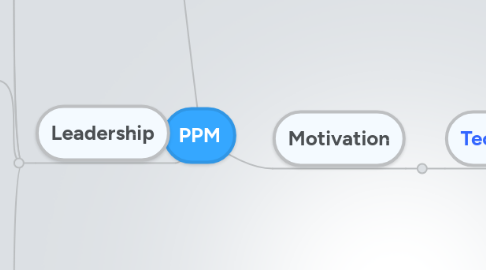
1. Leadership
1.1. Leader
1.2. Leadership
1.3. Teori
1.3.1. Early Theories
1.3.1.1. Trait
1.3.1.1.1. 7 Traits that make leaders successful
1.3.1.2. Behavioral
1.3.1.2.1. IOWA
1.3.1.2.2. OHIO
1.3.1.2.3. MICHIGAN
1.3.1.2.4. Managerial Grid
1.3.2. Teori Contingency
1.3.2.1. Fiedler
1.3.2.1.1. Leader-Member Relationship
1.3.2.1.2. Task Structure
1.3.2.1.3. Position Power
1.3.2.2. Hersey and Blanchard
1.3.2.2.1. Telling
1.3.2.2.2. Selling
1.3.2.2.3. Participating
1.3.2.2.4. Delegating
1.3.2.3. Path-Goal Model
1.3.2.3.1. Directive Leader
1.3.2.3.2. Supportive Leader
1.3.2.3.3. Participative Leader
1.3.2.3.4. Achievement Oriented Leader
1.3.3. Teori Kontemporer
1.3.3.1. Transformational Theory
1.3.3.1.1. Leader menstimulasi dan menginspirasi karyawan untuk mencapai extraordinary goals
1.3.3.2. Transactional Theory
1.3.3.2.1. Leader guides and motivates employee by giving rewards
1.3.3.3. Visionary
1.3.3.3.1. kemampuan leader untuk memciptakan visi yang realistis, credible, dan dapat mengimprove keadaan sekarang
1.3.3.4. Charismatic
1.3.3.4.1. leader yang antusias dan penuh PD, yang perilakunya mempengaruhi karyawan untuk berperilaku tertentu
1.4. Power
1.4.1. Legitimate Power
1.4.1.1. power yang berasal dari jabatannya
1.4.2. Coercive Power
1.4.2.1. power untuk memaksakan kehendak dan memberikan hukuman
1.4.3. Reward Power
1.4.3.1. power untuk mengendalikan perilaku karyawan dengan meng-iming imingi hadiah
1.4.4. Expert Power
1.4.4.1. power yang berasal dari keahlian dia di bedang bersangkutan
1.4.5. Referent Power
1.4.5.1. power yang berasal dari personal trait yang disukai karyawan
2. Control
2.1. Pengertian, Tujuan
2.1.1. process of monitoring, comparing (against the desired standard), and correcting work performance.
2.1.2. tujuan secara umum: manager tahu apakah goals sudah tercapai, bila tidak, apa alasannya
2.1.3. Value of control function
2.1.3.1. Planning
2.1.3.1.1. tahu plan-nya terlaksana atau tidak, dan apa plan kedepannya nanti
2.1.3.2. Empowering employees
2.1.3.2.1. feedback ke employee
2.1.3.3. Protecting the workplace
2.1.3.3.1. meminimalkan gangguan dalam organisasi
2.1.4. Controlling Link
2.1.4.1. POLC
2.2. Control Process / Perfomance Standards
2.2.1. 1. Measuring actual performance 2. Comparing actual performance against a standard 3. Taking action to correct deviations or inadequate standards
2.3. HOW we measure
2.3.1. POWS
2.4. WHAT we measure
2.4.1. Employee
2.4.1.1. S atisfaction
2.4.1.2. A bsenteeism
2.4.1.3. T urnover
2.4.2. Budget
2.4.2.1. C ost
2.4.2.2. O utput
2.4.2.3. S ales
2.5. Managerial Action
2.5.1. Immediate Corrective Action
2.5.2. Basic Corrective Action
2.6. Types of Control
2.6.1. Feedforwad Control
2.6.2. ConCurrent Control
2.6.3. Feedback Control
2.6.4. Management by Walking
3. Motivation
3.1. Teori
3.1.1. Early Theories
3.1.1.1. Maslow
3.1.1.1.1. Psikologi
3.1.1.1.2. Safety
3.1.1.1.3. Social
3.1.1.1.4. Esteem
3.1.1.1.5. Self Actualization
3.1.1.2. McGregor
3.1.1.2.1. Teori X
3.1.1.2.2. Teori Y
3.1.1.3. McClelland
3.1.1.3.1. nAch
3.1.1.3.2. nPow
3.1.1.3.3. nAff
3.1.1.4. Herzberg
3.1.1.4.1. Hygiene Factors
3.1.1.4.2. Motivator
3.1.2. Teori Kontemporer
3.1.2.1. Goal Setting Theory
3.1.2.1.1. self-efficacy
3.1.2.2. Reinforcement Theory
3.1.2.2.1. konsekuensi ditimbulkan tergantung pada perilaku
3.1.2.3. Designing Motivating Jobs
3.1.2.3.1. Job Design
3.1.3. Teori Equity
3.1.4. Teori Ekspektansi
3.1.4.1. dimana karyawan cenderung bersikap seperti seharusnya, untuk meng-expect outcome yang diharapkan
